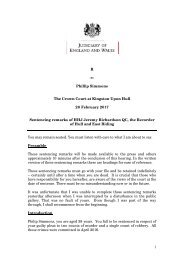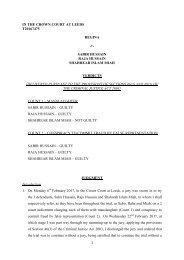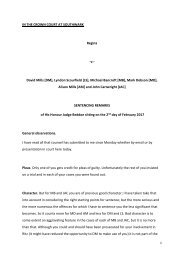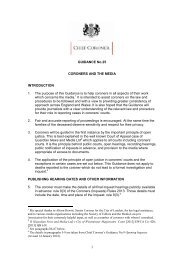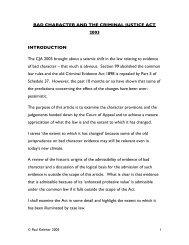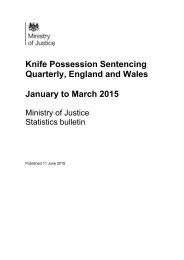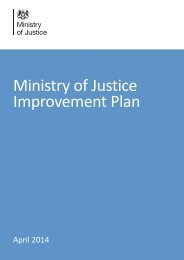HMP Doncaster
Doncaster-web-2015
Doncaster-web-2015
You also want an ePaper? Increase the reach of your titles
YUMPU automatically turns print PDFs into web optimized ePapers that Google loves.
Section 1. Safety<br />
Substance misuse<br />
Expected outcomes:<br />
Prisoners with drug and/or alcohol problems are identified at reception and receive<br />
effective treatment and support throughout their stay in custody.<br />
1.60 Outcomes for prisoners needing substance misuse treatment were poor, and staffing shortages and<br />
other issues hindered patient care. First night prescribing was inconsistent, prescribing protocols did<br />
not adhere to national guidance, and around half of clinical reviews were not completed on time.<br />
1.61 Clinical and psychosocial drug services were provided by Nottinghamshire Healthcare NHS<br />
Foundation Trust. The provision was poorly integrated into the strategic management and<br />
day-to-day running of the prison. The new drug and alcohol strategy and action plan were<br />
not based on a needs analysis (see recommendation 1.68). Communication between the<br />
substance misuse service and other prison departments was poor (see paragraph 4.30).<br />
Prisoners receiving adjudications for positive drug tests were not routinely referred to the<br />
substance misuse service (see paragraphs 1.47–1.48).<br />
1.62 Drug recovery workers were well qualified but prisoners often had to wait too long to see<br />
them because there were not enough staff at the required local NHS grade to complete<br />
assessments and initiate care plans. The recovery wing had been closed for nearly a year and<br />
all recovery-based groupwork had ceased. Alcoholics Anonymous meetings were not<br />
available. The programmes team delivered lower intensity groupwork focusing on awareness<br />
of new psychoactive substances (NPS), 6 but this was not well integrated into an overall<br />
strategic approach to tackling drugs.<br />
1.63 Of the 213 prisoners receiving opiate substitution treatment, 93 were on maintenance doses<br />
and 120 were reducing. First night prescribing was in place and most new arrivals with opiate<br />
substitution needs were located on the stabilisation wing for their first five days. However,<br />
not all prisoners arriving late had a consultation with a doctor to get a first night<br />
prescription, and some spent their first night with no opiate substitution.<br />
1.64 As at the last inspection, all new arrivals on a community dose of more than 40ml of<br />
methadone had this automatically reduced by 25%. This policy did not reflect individual need<br />
or the national guidelines for substance misuse treatment.<br />
1.65 Methadone was administered from three separate hatches with varying levels of staff<br />
supervision, ranging from very close to lax oversight. While two officers were present at<br />
two of the hatches, there was only one to supervise the third hatch and escort prisoners<br />
back to the wing, leaving other prisoners unsupervised at the hatch.<br />
1.66 Clinical reviews for prisoners on opiate substitution were conducted by a non-medical<br />
prescriber and a part-time consultant psychiatrist, which was insufficient to keep up with<br />
demand. Around half of all reviews were not completed within the 13-week period set out<br />
by national guidance.<br />
1.67 In our survey, only 30% of prisoners, against the comparator of 59%, said they had received<br />
help for their drug problems, and only 38%, against 57%, said they had received help for an<br />
alcohol problem.<br />
6 Drugs that mimic the effects of illegal drugs, such as cannabis, heroin or amphetamines, and may have unpredictable and<br />
life-threatening effects.<br />
28 <strong>HMP</strong> <strong>Doncaster</strong>



